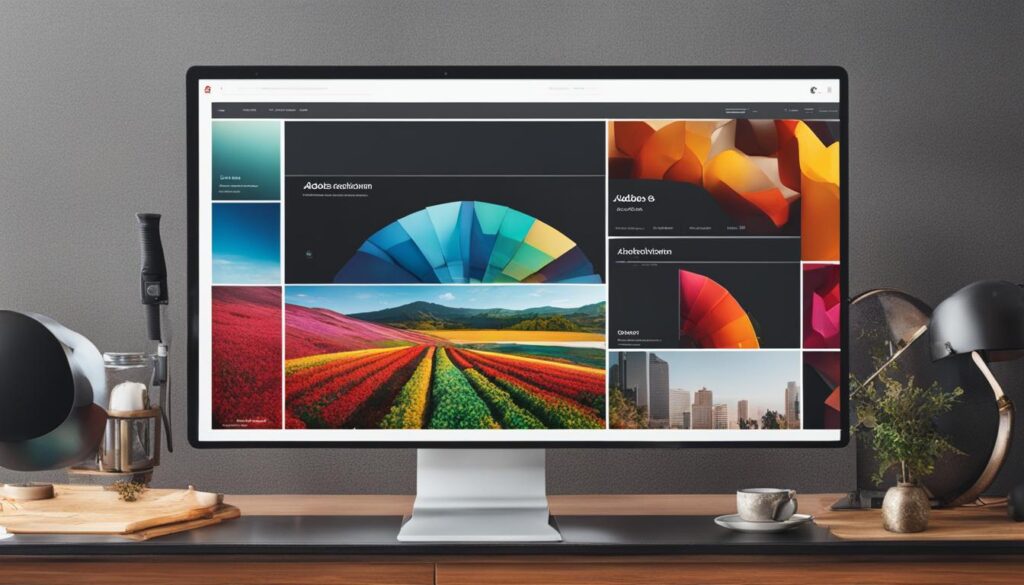5 Best Platforms for Digital Art Sales
As a digital artist, you put a lot of time and effort into creating stunning artwork. But what’s the point if no one sees it? That’s where platforms for digital art sales come in. These digital art selling websites provide a marketplace to showcase your digital art and sell your creations. Whether you are a seasoned digital artist or just starting out, a platform exists for you.
In this article, we will explore the 5 best platforms for digital art sales that offer great opportunities for artists to monetize their digital art. We will delve into the advantages and features of each platform so that you can choose the best one for your needs and start earning money from your creativity.
Key Takeaways:
- Platforms for digital art sales provide a marketplace for digital artists to showcase and sell their creations.
- There are many platforms available, each with their own unique features and advantages.
- The top 5 platforms for digital art sales are ArtStation, Society6, Etsy, Redbubble, and Adobe Stock.
- Digital artists can earn a significant income from selling their art online.
- Strategic planning and marketing efforts are essential for success in selling digital art.
Why Sell Your Digital Art Online?
Creating content for a website and selling digital paintings has become a lucrative source of income in today’s market. If you are a digital artist, selling your artwork online can be a game-changer for your career. By selling your digital art online, you can reach a global audience and earn a significant income from your creative work. With the advancement of technology, more people than ever are interested in digital art and are willing to purchase it. In fact, according to a recent survey, 90% of consumers consider digital art to be a legitimate form of art.
Selling digital art online allows you to break free from the traditional art market and its limitations. With online platforms, you can bypass galleries and middlemen and take full control of your sales. This means that you can set your own prices, keep a higher percentage of your earnings, and reach a wider audience.

Moreover, selling your digital art online enables you to build a personal brand and establish yourself as an artist in the digital world. By consistently creating and promoting your work on various platforms, you can attract more potential buyers and increase your visibility in the art community. If you’re wondering how to sell digital art online and make money, explore these strategies to elevate your digital art business.
If you’re serious about turning your digital art into a profitable online business, it’s advisable to familiarize yourself with the fundamentals of entrepreneurship and business principles. Understanding the basics of business will empower you to navigate the digital art market more effectively and make strategic decisions to enhance your success.
Free Platforms for Digital Art Sales
In the realm of digital art sales, several platforms offer opportunities for artists to showcase and monetize their creations, and notably among them are free platforms for digital art sales, including ArtStation, Society6, Etsy, Redbubble, and Adobe Stock. While these platforms provide options for artists to exhibit their work without upfront costs, it’s essential to understand their unique fee structures and payment models.
For instance, Society6 and Redbubble allow artists to join for free, with earnings generated through the sale of products featuring their designs. Etsy, on the other hand, operates on a fee system, charging for listings, transactions, and payment processing.
Meanwhile, ArtStation offers a combination of free and paid plans, with commissions on sales for the free version. Free platforms for digital art sales like Adobe Stock operate on a royalty basis, providing a marketplace for artists to license their digital art.
Navigating these platforms strategically and considering individual preferences can enable artists to maximize their visibility and sales potential in the expansive world of digital art. Let’s discuss them in detail.
Platform A: ArtStation
If you’re looking for a platform to sell your digital art, ArtStation is an excellent choice. The platform is popular among digital artists, offering a user-friendly interface and a dedicated community. With its wide range of categories, you can easily showcase your digital art and connect with potential buyers.
Pros:
- ArtStation offers a diverse range of categories, allowing digital artists to showcase their work in various genres and styles. This diversity attracts a broad audience and provides artists with the flexibility to explore different artistic niches.
- The digital art selling website provides a user-friendly interface, making it easy for artists to customize their portfolios and showcase their digital art professionally.
- Has a dedicated community of digital artists. This sense of community allows artists to connect, share insights, and collaborate, fostering a supportive environment for creative professionals.
- Artists on ArtStation can customize their portfolios to present their work in a professional and visually appealing manner. This customization feature enhances the overall presentation of digital art, making it more attractive to potential buyers.
- ArtStation employs a secure payment system, ensuring that artists receive their payments promptly and without hassle.
Cons:
- The popularity of ArtStation means there is high competition among digital artists. It can be challenging to stand out on a platform that many professionals use, especially for newcomers.
- ArtStation charges a commission on sales, and this commission may be slightly higher compared to other platforms. Artists should consider the impact of these fees on their overall earnings.
This digital art selling website also provides many features that make it reliable and convenient for selling your digital art. For instance, you can customize your portfolio to showcase your work professionally. Additionally, a secure payment system ensures you receive your payment promptly and without hassle. Explore how to sell digital art online and make money with ArtStation’s user-friendly platform and dedicated community.
Overall, ArtStation is an excellent platform for selling your digital art, particularly if you specialize in digital art and want to connect with a vast community of digital artists.

Platform B: Society6
If you’re looking for a hassle-free way to sell your digital art as various products, consider Society6. This print-on-demand platform handles the printing, shipping, and customer service, so you can focus solely on creating more artwork. Society6 offers a wide range of products to showcase your digital art, including prints, home decor, and apparel.
Pros:
- It handles the entire process of printing, shipping, and customer service, allowing artists to focus solely on creating artwork. This hassle-free approach simplifies the selling experience.
- The platform provides a wide array of products to showcase digital art, including prints, home decor, and apparel. This diversity allows artists to explore various mediums for presenting their creations.
- It has an established user base, providing artists with immediate access to a community of potential buyers. This built-in audience enhances the visibility of artists’ work and increases the likelihood of sales.
- Artists have the flexibility to set their own profit margins on products. This control over pricing empowers artists to determine the value of their work and optimize earnings based on individual preferences and strategies.
- Society6 ensures a secure payment system, providing peace of mind for both artists and buyers. This reliability in financial transactions contributes to a trustworthy and professional selling environment.
Cons:
- Artists may face limitations in controlling the production process as Society6 takes charge of printing and shipping. This lack of direct control over the physical aspects of their creations could be a drawback for artists who prefer hands-on involvement.
- Fixed base prices for products, impacting the profit margins of artists. While artists can control their markup, the fixed base prices can influence the overall perceived value of their artwork.
With a built-in audience, Society6 provides an excellent opportunity for artists to reach potential buyers. Plus, it offers a feature where artists can set their own profit margins, allowing full control over pricing and profits. You can trust that your art is secure as Society6 also offers a secure payment system.
Take advantage of the community and network with other artists on the platform. This will help in gain more exposure and increase your reach. Selling on Society6 is easy and uncomplicated, making it a great choice for digital artists looking to monetize their creativity.

Platform C: Sell Digital Art on Etsy
If you’re looking for a platform that caters to a diverse range of products, including digital art, sell digital art on Etsy. With a strong community of artists and buyers, Etsy offers a marketplace where you can easily sell your digital artwork.
Etsy allows you to customize your shop to fit your brand and leverage various marketing tools to promote your digital art to a larger audience. You can easily showcase your digital art to potential buyers and make hassle-free sales.
Pros:
- Etsy caters to a wide range of products, including digital art, handmade items, and vintage goods. This diversity allows digital artists to join a marketplace with a broad audience interested in unique and creative offerings.
- Provides users with the ability to customize their shopfronts, allowing artists to establish a unique brand presence. This customization helps in creating a visually appealing and cohesive representation of an artist’s work.
- Has a strong and engaged community of both artists and buyers. Being part of this community provides opportunities for networking, collaboration, and mutual support among artists.
- Offers search engine optimization (SEO) tools to enhance the discoverability of digital art. This feature enables artists to optimize their product listings, making it easier for potential buyers to find and purchase their work.
- Encourages direct interaction between artists and buyers through features like messaging and reviews. This personal connection can foster trust and loyalty, contributing to a positive buying experience.
Cons:
- Etsy charges listing fees for each product, and there are transaction costs associated with each sale. For artists with a high volume of listings or sales, these fees can accumulate and impact overall earnings.
- The popularity of Etsy means there is substantial competition among sellers. Standing out in a crowded marketplace can be challenging, especially for new or lesser-known artists.
To further elevate your sales performance, you can use Etsy’s search engine optimization (SEO) tools to make your digital art more discoverable to potential buyers. With its user-friendly interface and extensive features, Etsy is a great platform to maximize your digital art sales. Sell digital art on Etsy and leverage its tools to enhance your visibility and reach a broader audience.

Platform D: Redbubble
Redbubble is a popular print-on-demand platform that provides a unique opportunity for digital artists to sell their art on various products. With Redbubble, you can monetize your creativity and earn passive income on products like clothing, home decor, and stickers.
Pros:
- Redbubble operates on a print-on-demand model, meaning artists don’t need to handle printing, shipping, or inventory management. This hands-off approach allows artists to focus solely on creating and promoting their digital art.
- Offers a wide array of products for artists to showcase their designs, including clothing, home decor, stickers, and more. This diversity provides artists with various mediums to express their creativity and appeal to different audiences.
- Provides a user-friendly interface for artists to upload their designs, customize listings, and manage their shops. This simplicity makes it accessible for both seasoned and new digital artists.
- Has a global reach, allowing artists to reach a wide and diverse audience. The platform’s international presence increases the potential for artists to connect with buyers from different parts of the world.
- Artists on Redbubble have flexibility in customizing their product listings, allowing them to add descriptions, tags, and categories. This customization enhances the visibility of their work and helps potential buyers find specific pieces.
Cons:
- Redbubble sets the base prices, but artists can add their own markup to products. This limitation on pricing control may impact the perceived value of an artist’s work.
- As a print-on-demand platform, artists may have limited control over the quality of the final printed products. Ensuring that the printed versions accurately represent the digital artwork can be a concern.
The platform has a user-friendly interface that makes it easy for artists to upload their designs, customize their listings, and handle the fulfillment process. Plus, Redbubble offers a wide range of customization options, ensuring that your art stands out and meets the needs of your audience.
If you want to sell your digital art on Redbubble, start by creating an account and setting up your shop. Then, upload your designs and customize your listings with product descriptions, tags, and categories.
Redbubble handles the printing, shipping, and customer service, making it a convenient platform for artists to sell their digital art. Plus, the platform offers a built-in audience of buyers, giving you more exposure and sales opportunities.

Platform E: Adobe Stock
Adobe Stock is a reputable platform that focuses on licensing digital assets, including digital art. By submitting your artwork to Adobe Stock, you can earn royalties whenever your art is licensed for use. As one of the leading platforms in the creative industry, Adobe Stock provides a reliable marketplace for digital artists to sell their creations.
Pros:
- Adobe Stock boasts a vast library of high-quality digital assets, including photos, videos, graphics, and templates. This extensive collection provides a diverse range of content for creative professionals.
- Adobe Stock seamlessly integrates with other Adobe Creative Cloud apps. This integration simplifies the process of uploading and licensing digital art directly from favorite creative software, enhancing workflow efficiency for artists.
- Reputable and well-established platform in the creative industry. Its credibility attracts a broad audience of buyers, providing artists with exposure to a professional and trustworthy marketplace.
- Artists can license their digital art on Adobe Stock, earning royalties whenever their work is used. This royalty-based system allows artists to monetize their creations on an ongoing basis.
- Adobe Stock provides a reliable payment system for artists, ensuring that they receive their earnings promptly. This financial reliability contributes to a positive experience for contributors.
Cons:
- To contribute to Adobe Stock, artists need a subscription to Adobe Creative Cloud. This subscription requirement may be a barrier for some artists, especially those who prefer standalone creative tools.
- Adobe Stock has an approval process for submitted artwork. This process ensures the quality and appropriateness of content, but it can result in delays for artists awaiting approval.
Adobe Stock boasts a vast library of high-quality digital assets, including photos, videos, graphics, and templates, making it a one-stop-shop for creative professionals. By leveraging Adobe Stock’s integration with other Adobe Creative Cloud apps, you can easily upload and license your digital art without leaving your favorite creative software.
Overall, Adobe Stock is a great platform for artists looking to license their digital art and earn royalties. With its integration with Adobe Creative Cloud and reliable payment system, Adobe Stock provides a convenient and trustworthy marketplace for digital creatives. With these platforms, you don’t need to fret over how to sell digital art and make money.

Tips for Success in Selling Digital Art
Now that you know the best platforms for digital art sales to sell your digital art, it’s time to focus on optimizing your sales strategy. Here are some valuable tips to help you succeed:
1. Create Compelling Product Descriptions
Invest time in creating descriptive and engaging product descriptions that accurately reflect the uniqueness and value of your digital art. Use vivid language to capture potential buyers’ imagination and highlight your artwork’s benefits.
2. Utilize Social Media Marketing
Don’t neglect the power of social media marketing to promote your digital art. Platforms like Instagram, TikTok, and Pinterest can help you reach a wider audience and attract potential buyers. Use hashtags, collaborate with other artists and influencers, and engage with your followers to build your brand.
3. Pricing your Digital Art Appropriately
Pricing your digital art is essential to selling it effectively. Do research on the average prices for art similar to yours on the platform you choose to sell on. Make sure your pricing is consistent with your skill level and the quality of your artwork.
4. Use High Quality Images
Ensure that the images that showcase your digital art are of high quality. Use professional tools to create the best images that highlight the unique aspects of your artwork.
By implementing these tips, you can create a successful sales strategy for selling your digital art. Remember, consistency is key, and always look for opportunities to improve your skills and grow your audience.
Tips for Success in Selling Digital Art
If you are looking to sell your digital art successfully, then you need to be strategic in your approach. Here are some tips that will help you maximize your sales potential:
- Create High-Quality Artwork: Your digital art should be of high quality and visually appealing to attract potential buyers. Ensure that you showcase your best work to increase the chances of making a sale.
- Write Compelling Product Descriptions: Your product descriptions on digital art selling websites should be clear and concise, highlighting the unique features of your artwork. Use descriptive language and provide all necessary information about the digital art you are selling.
- Pricing: Price your digital art reasonably to attract potential buyers. Research the market-free platforms for digital art sales to know the average price range for similar artworks before setting your price.
- Social Media Marketing: Leverage social media to promote your digital art. Share your artwork on social media platforms such as Instagram, Twitter, and Facebook, and use relevant hashtags to increase visibility.
- Engage with Potential Buyers: Engage with potential buyers by responding to their queries and comments. Demonstrate your expertise and willingness to help them make informed decisions.
- Regularly Update Your Portfolio: Keep your portfolio up to date with new artwork to keep your audience interested. Consistently producing unique content also helps establish your authority in the digital art industry.
- Offer Discounts: Consider offering discounts on your artwork to attract potential buyers. This strategy can help you reach a wider audience and generate more sales.
By incorporating these tips into your sales strategy, you can increase your chances of selling your digital art successfully and establishing yourself as a reputable digital artist.
Conclusion
In summary, digital artists can monetize their creations on platforms like ArtStation, Society6, Etsy, Redbubble, and Adobe Stock. These platforms offer diverse features, allowing artists to reach a global audience, set their prices, and establish a personal brand.
Selling digital art online breaks traditional market constraints, but success requires strategic planning, effective marketing, and adherence to tips like high-quality artwork creation and appropriate pricing. Each platform has its unique advantages, catering to different preferences. Ultimately, artists can navigate and thrive in the dynamic online art sales landscape using these versatile platforms.
FAQs About Platforms for Digital Arts Sales
Q: What platform is best for selling digital art?
A: Each platform we’ve discussed—ArtStation, Society6, Etsy, Redbubble, and Adobe Stock—offers unique features catering to different needs. Artists can choose the best fit based on their goals, whether it’s building a personal brand, reaching a specific audience, or leveraging print-on-demand services. Ultimately, the “best” platform is subjective and varies according to individual priorities and business strategies.
Q: What is the best way to sell digital art?
A: The best way to sell digital art depends on individual preferences, but popular methods include platforms like ArtStation, Society6, Etsy, Redbubble, and Adobe Stock, each offering unique features and opportunities for artists to showcase and monetize their creations.
Q: Where can I sell digital paintings online?
A: You can sell digital paintings online on platforms like ArtStation, Society6, Etsy, Redbubble, and Adobe Stock.
Q: Where can i sell my digital art for free?
A: The answer to where can i sell my digital art for free is simple, You can sell your digital art for free on platforms like ArtStation, Society6, Etsy, Redbubble, and Adobe Stock.

